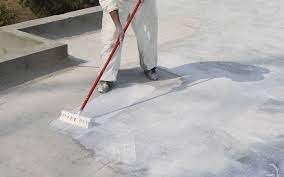
Chemical waterproofing is a process of applying a waterproofing chemical to the surface of a building to prevent moisture from penetrating through. The chemical is usually a liquid or a paste that is applied to the surface using a brush, roller, or sprayer. The chemical penetrates into the surface and forms a barrier that prevents water from penetrating into the structure.
There are various types of chemical waterproofing solutions available, including cementitious waterproofing, elastomeric waterproofing, and bituminous waterproofing. The choice of chemical waterproofing will depend on the specific needs of the building and the type of waterproofing problem being addressed. Chemical waterproofing is commonly used on concrete structures, such as basement walls, to prevent water from penetrating into the structure. It is also used on roofs, balconies, and other exterior surfaces to prevent water from seeping into the building. Chemical waterproofing can be a cost-effective and durable solution for waterproofing, but it is important to ensure that the chemical is applied properly and that the surface is well-maintained to ensure its effectiveness over time.
Is chemical waterproofing durable?
The durability of chemical waterproofing depends on several factors, including the type of chemical used, the surface it is applied to, and the conditions the surface is exposed to.
In general, chemical waterproofing can be a durable solution for waterproofing, especially if it is applied properly and the surface is well-maintained. Proper application involves ensuring that the surface is clean, dry, and free of cracks or holes before applying the chemical. The surface should also be properly prepared by applying a primer to improve adhesion.
However, it is important to note that the durability of chemical waterproofing can be impacted by exposure to extreme weather conditions, UV light, and other factors that can cause the chemical to degrade over time. Regular maintenance, such as reapplying the waterproofing chemical, may be necessary to maintain its effectiveness.
How to do chemical waterproofing?
Chemical waterproofing is a process of applying a waterproofing chemical to the surface of a building to prevent moisture from penetrating through. Here are the steps to chemical waterproofing your home:
- Clean the Surface: Clean the surface thoroughly to remove any dirt, debris, or loose material.
- Repair any cracks or holes: Fill any cracks or holes in the surface to prevent moisture from entering through these areas.
- Apply Primer: Apply a waterproofing primer to the surface to ensure good adhesion of the waterproofing chemical.
- Apply Waterproofing Chemical: Apply the waterproofing chemical to the surface using a brush, roller, or sprayer, making sure to follow the manufacturer’s instructions for application.
- Allow the Chemical to Dry: Allow the waterproofing chemical to dry completely, which may take several hours or overnight, depending on the product.
- Inspect the Surface: Inspect the surface to ensure that the chemical has been applied evenly and that there are no missed spots or areas that need touch-up.
It is important to note that chemical waterproofing products can be hazardous if not handled and applied properly. Always follow the manufacturer’s instructions and safety precautions, and consider hiring a professional if you are unsure about the process.
Where chemical waterproofing can be done?
Chemical waterproofing can be done on various structures and surfaces such as:
- Basements
- Bathrooms and kitchens
- Roofs and terraces
- Swimming pools and tanks
- Bridges and tunnels
- Retaining walls and dam
- Water treatment plants and sewage systems
- Podiums and balconies
- Prefabricated structures and temporary shelters
- Concrete and masonry surfaces
The specific type of chemical waterproofing solution used depends on the surface and the degree of waterproofing required.


